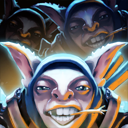and then
link it to
reddit for free easy karma
Why do this now? Well, a lot of what I'm going to bring up can be easily addressed and my points illustrated in terms of what we're expecting to see in 7.07. I'm going to break down the discussion into a few key points and try to keep this structured, rather than ramble on as I am wont to do.
Warning.
Maths.
Foreword 1: 7.07 predictions, and "leaks"
As with any leaks, take these with a really hefty grain of salt. A while ago on 4Chan (lul), there was apparently a "Valve insider" who leaked some of the changes that would occur in 7.07. It's a high chance these are completely false, but they do look really cool. What I want to focus on now is the proposed talents changes, which would take them from levels 10, 15, 20, and 25 to 9, 13, 17, 21, and 25, thereby giving each hero a fifth row of talents.
I'm going to come back to this later in reference to an upcoming point, so keep this potential leak in the back of your mind. For what it's worth, I really do hope this leak is true, because it'll be hugely impactful and open up a vast, vast amount of possibilities regarding hero strengths, weaknesses, power spikes, and scaling.
Foreword 2: Differentiating types of carries
The term "hard carry" has somewhat fallen out of vogue as the position one role has become less dominant in the lategame. Ever since 6.84, we've seen gold being redistributed more evenly across a team - supports are no longer dirt poor, offlaners are no longer sacrificial lambs, and the mid has shifted from a ganker and roaming role to a secondary (or in some cases, the primary) core. Dual core lineups have been popular since TI3 or even before, but these days it's extremely common to have two farm-dependent scaling cores.
"Hard carry" used to be your #1, who would vacuum up the farm on the map and scale into the lategame extremely well due to a massive gold advantage. Heroes like
This has blurred the line between carry and hard carry. It's no longer about sheer scaling, since that's far less relevant in a world where 1v5s simply aren't feasible to execute even if you're 15k gold ahead of the enemy cores. What's it about, then?
Uselessness early-game? Not really.
The hard carry role these days is best defined by the lategame, when they are most relevant. And not necessarily in teamfights, although that is of course a factor. So to try and define a hard carry, let's look at the main topic of this article; hero scaling.
The Nuts and Bolts of Scaling
Scaling is a term that simply refers to how good a hero is later in the game. A hero that scales well will remain relevant well past 50 minutes; one that does not scale well, or 'drops off' peaks well before then, and fades off compared to other heroes.
So what constitutes and determines how well a hero scales?
I did a post a short while back with the endgame, fully slotted stats of most of the carries in the game. Now, while that post is all well and good in a vacuum, it's a bit misleading in a lot of cases; not everyone had the same net worth, and some item builds weren't standard - you wouldn't really get
Multiplication is king in terms of scaling. Let's say you have two hypothetical effects - one gives +100 damage, and the other one gives 100% more damage. If you take a Dota hero, they might only have 50 damage in the early game, so +100 damage is much more impactful. But as the game goes on, heroes crack 200, 300, even 400 damage... so 100% more damage will result in a much larger net gain.
That's scaling at its absolute most basic form. Addition and multiplication to find out what gives the biggest numbers. Now, if you go through that post and thread to find all the stats, you'll notice something interesting.
Most heroes end up with comparable DPS, HP and armour with a balanced endgame item build. A fully kitted up Agility carry can expect to hover around 3k Health, 25-30 armour, and 2-3k DPS. This can seem especially strange when you compare heroes like
Well, the reason why heroes tend to have fairly comparable stats is because scaling in Dota 2 is very carefully balanced and capped. We can meme OSFrog all we like, but at the end of the day, Icefrog is damn good at his job and we're privileged to have him working on the game. Item stat bonuses such as that from
So from this section we've concluded that multiplication scales better than addition. Multiplicative health and armour sources don't exist in the game, so we've just got damage to go on. Multiplicative damage steroids include:
- Illusions - they deal a percentage of the main hero's base damage.
- Critical strikes - their critical chance and critical strike multiplier work together to increase the hero's total damage by a percentage. Works on illusions, so if you want to scare the **** out of someone in a pub buy
 Daedalus on
Daedalus on  Terrorblade.
Terrorblade. - Base attack time improvements - due to the way attack speed is calculated in Dota, improved BAT will increase your attack rate by a percentage. This works out to a total DPS increase.
- Clone effects. This means
 Divided We Stand and
Divided We Stand and  Tempest Double.
Tempest Double.
Stat Gain
This is one of the most misleading and misunderstood aspects of a hero's scaling. Good stat gain is touted as super-important to your hero, whereas in reality you either have to have greatly exceptional or greatly awful stat gain for it to be noticeable at all.
To illustrate this point, I'm going to look at Agility carries because those are the most common kind of carries you get. Point for point, Agility is the most impactful of all stats, but that's a subject for another article. The average Agility gain for Agility carries is 2.52, which is right at the level
By 'abuse stats', I mean multiply the amount of stats you get via illusions or clones. Medusa doesn't do either of this - if you get
Medusa's base Agility is 20, and she gains 2.5 per level, for a total of 80 at level 25. A common buff/nerf Icefrog performs is increasing or decreasing Agility gain by between 0.3 and 0.5 - it's happened to Sniper, Juggernaut, Spectre and Phantom Lancer as nerfs, and Morphling, Mirana, Clinkz and Luna as buffs. So let's up Medusa's Agility gain from 2.5 to 3.0 and see where that takes us.
It nets us an extra 12 Agility at level 25. That's 12 damage, 12 attack speed, and a touch under 2 armour. When you consider that carries are closing in on 300 damage and 25 armour by that point, it's not really a big deal, is it? You've got an extra 4% damage. More noticeable is the 12% reduction to incoming physical damage, but even that isn't going to be as valuable as a solid boost to your Health on most heroes.
Ok, but what if a hero can abuse stats? I had a similar discussion to this with Cuki, who is in the top 50
Currently,
But he has
30 dps doubled is still not a lot on a hero that already cracks 3000 relatively effortlessly. It's 2%. Like I said, more impactful is the armour from a stats gain, but 1.5 armour and 60 DPS won't catapult Arc Warden to first-ban territory.
Relating to the Styles of Carries
So clearly, simple stats aren't going to show the differences between carries and hard carries. Have the roles just blended together?
Well, arguably, to some extent, they have. However, I believe that what defines a hard carry in the modern era isn't their stats, but their impact on the lategame. A hard carry will warp the lategame around them, fundamentally changing how it is played, on top of being a beast in scaling. Let's look at
Similar aspects are echoed in
I'd also add
Scaling via Talents
This should hopefully be the last part of this rather long and wordy assignment. I mentioned at the very beginning the prospect of a new row of talents being added. Hopefully, from reading later sections, you've gotten an idea for how murky the distinction between 'carry' and 'hard carry' can be, and how it's mostly based on abilities rather than stats.
That's where talents come in. Uniquely in Dota, talents modify both stats and abilities, leaving a lot of options open for scaling a hero. A common criticism of a lot of talents is that they're very bland on a lot of heroes, providing mere boosts to damage, health, or stats as opposed to more objectively interesting ability changes.
An interesting avenue of balancing appears from this, one Icefrog does not seem interested in taking, but one that seems pertinent to discuss nonetheless. Hard carries are such because their abilities are so impactful on the lategame, yet they also maintain impressive scaling that's often at the very top end of statistics - again, refer back to the stats threat I linked earlier. If a hard carry as we understand them requires both of these prerequisites to be fulfilled, this means talents can be used to direct a hero in a certain direction. If the leak about a fifth talent row was true, we may well could be seeing something akin to this appear. Hard carries tend to have abilities that are complete on their own, and often a talent modification to that ability simply isn't better than piling on more stats. An example of this is
Should a fifth row of talents be added, we will likely see hard carries strip way ahead in terms of numerical scaling as their new talents are merely stat boosts. Recent design tends to lean towards spell modifications being focused on for talents - the removal and replacement of respawn reduction talents is a prime example. Whereas
Conclusion
I feel I got somewhat off of my original topic, but it was all loosely related in the end. Scaling in Dota 2 is a fairly complex aspect of the game that has had new layers of depth added with talents while still remaining close to its core concepts. Indeed, talents are the most impactful way to play with a hero's scaling - though, Icefrog's subtle touch and keen intuition leads him towards the more restrained alteration of attribute gain.
I ended up conglomerating two topics into one, addressing both scaling and the functions of different carries, so hopefully the next article I do will be more focused in its scope. I hope you found this topic as interesting to read about as I did to write about.
















Quick Comment
You need to log in before commenting.
[-] Collapse All Comments